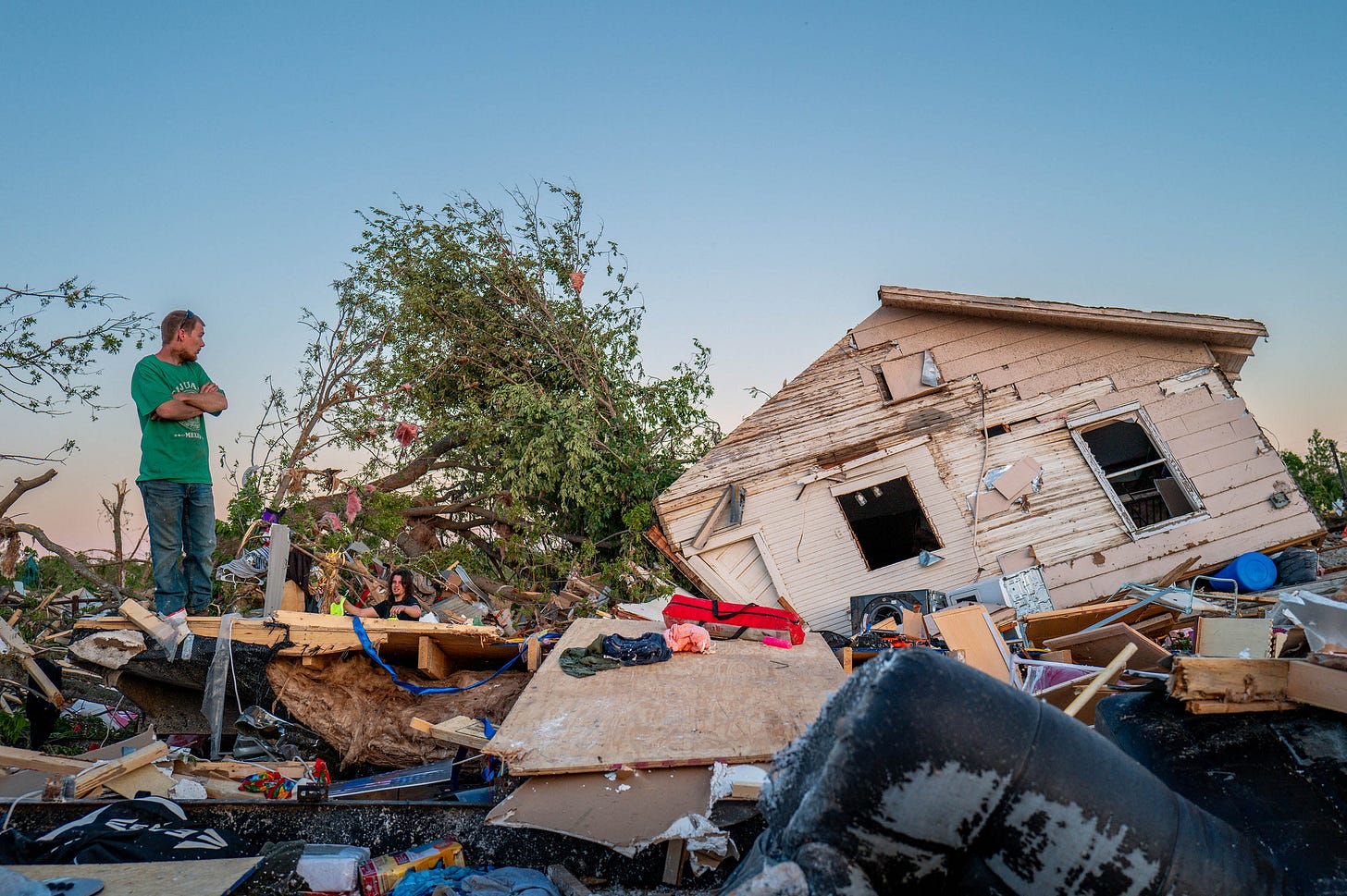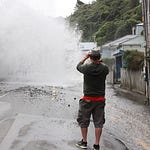
TL;DR: Here’s the top six news items of note in climate news for Aotearoa-NZ this week, and a discussion above between Bernard Hickey and The Kākā’s climate correspondent Cathrine Dyer:
A year of record-breaking surface temperatures has spawned a month of global extreme weather chaos in May, including howler monkeys falling dead from trees in Mexico during a ferocious heatwave that is also threatening to run Mexico City dry of water
Meantime, Brazil has more water than it can handle as biblical-scale floods displace more than half a million people in the state of Rio Grande do Sul.
Tornado-spawning thunderstorms killed 21 people, destroyed hundreds of buildings and disrupted Memorial Day weekend traffic in the US. The so-called‘kitty cat’ storms (as opposed to ‘nat cat’ for nationally catastrophic storms) have sent the insurance industry reeling at the accumulated scale of losses.
North India has been suffering through an intense heat wave that experts say has surpassed 50˚C on the heat index (the apparent or experienced temperature) due to high levels of humidity. Hospitals in Delhi have been forced to set up special facilities to treat the increasing numbers of patients experiencing heat-related illnesses.
And then there was the devastating landslide in Papua New Guinea that buried an entire village, part of a series of landslides driven primarily by the country’s unique geography. However, experts warn that climate change, particularly in the form of intensified rainfall events, can overwhelm the landscape’s ability to cope and contribute to landslides.
Climate change could be producing more diarrhoea-causing cryptosporidium outbreaks in Aotearoa, according to a new study from the University of Otago.
(See more detail and analysis below, and in the video and podcast above. Cathrine Dyer’s journalism on climate and the environment is available free to all paying and non-paying subscribers to The Kākā and the public. It is made possible by subscribers signing up to the paid tier to ensure this sort of public interest journalism is fully available in public to read, listen to and share. Cathrine wrote the wrap. Bernard edited it. Lynn copy-edited and illustrated it.)
Monkey fall from trees, water runs short in brutal heatwave
What follows a year in which average surface temperatures exceed the pre-industrial average by more than 1.5˚C, adding energy equivalent to four Hiroshima bombs (or Hiros) per second to Earth’s climate system? That massive pulse of energy, amplified by the effects of El Niño will take some time to dissipate.
In May alone we have seen extreme weather events unleash chaos in multiple locations around the world. Howler monkeys were falling from trees in Mexico, dead from heatstroke and dehydration as they suffered under a brutal heatwave that has killed at least 26 people since March.
“Wildlife biologist Gilberto Pozo counted about 83 of the animals dead or dying on the ground under trees. The die-off started around 5 May and hit its peak over the weekend.
“They were falling out of the trees like apples,” Pozo said. “They were in a state of severe dehydration, and they died within a matter of minutes.” Already weakened, Pozo says the falls from dozens of yards (meters) up inflict additional damage that often finishes the monkeys off.
Pozo attributes the deaths to a “synergy” of factors, including high heat, drought, forest fires and logging that deprives the monkeys of water, shade and the fruit they eat.
“This is a sentinel species,” Pozo said, referring to the canary-in-a-coalmine effect where one species can say a lot about an ecosystem. “It is telling us something about what is happening with climate change.” The Guardian
The effects of climate-driven drought, heatwave and low precipitation are combining with Mexico City’s long-running infrastructure problems to create a crisis in which the sprawling metropolis could run out of water entirely within weeks. The water crisis has become a bone of contention in the country’s upcoming presidential election
“In a Sunday debate between Claudia Sheinbaum of Mexico’s governing Morena party, and Xóchitl Gálvez, who represents an opposition coalition, Gálvez blamed the water issues on the inaction of Sheinbaum’s party. Sheinbaum, an environmental scientist who co-authored the 2007 Nobel Prize-winning Intergovernmental Panel on Climate Change report, is the former mayor of Mexico City.” The Washington Post
Meantime, Brazil has more water than it can handle, with epic, biblical-scale floods displacing more than half a million people. Concerns are mounting that conditions could spawn a health crisis as the displaced gather in temporary shelters ill-equipped for the scale of the disaster.
“More than 580,000 people have been displaced, with almost 70,000 of them depending on shelters, according to a state government report. A total of 2.3 million people have been affected by the torrential rain and floods.
City, state and federal governments are working to provide assistance, but the authorities estimate that the situation will take months or even years to return to normal. More than 90% of Rio Grande do Sul’s 497 municipalities have been affected, with 418 declaring a state of emergency or disaster.” The Guardian
Tornado season becomes even deadlier
‘Tornado-spawning thunderstorms’ have killed at least 21 people and destroyed hundreds of buildings across four US states, disrupting Memorial Day weekend travel plans for millions. At least 30 million people were under severe thunderstorm advisories in New Jersey, New York and Pennsylvania on Memorial Day this week as the storms headed Northwest from Arkansas, Texas, Kentucky and Oklahoma.
Just last week, the BBC warned that climate change was altering the behaviour of tornado season, in terms of both location and duration. Establishing the link between fleeting weather events like tornadoes and climate change is more complex than for other weather events like hurricanes and heatwaves, but there most certainly is a connection they report:
"We expect that the number of days in any given year that are favourable for tornadoes… are going to increase in the future and specifically increase earlier in the season," Victor Gensini, associate professor of meteorology at Northern Illinois University, tells the BBC.
Across the US's southern Plains states like Oklahoma and Kansas, "what might have been May and April as your peak months are now March, April, and May or even February", Gensini says. He notes that there hasn't been an uptick in strong tornadoes – tornadoes at EF4 ratings and higher – over the last 50 years, but where they occur has been changing.
States notorious for tornadoes such as Texas, Oklahoma and Kansas are actually seeing a decrease in tornadoes while states like Tennessee, Georgia and Arkansas as well as upper Midwest states like Minnesota, Illinois and Iowa are seeing an increase.
"We have way more people living in the mid-south and east of the Mississippi River than we do in the Great Plains," Gensini says. The higher population densities of the states seeing an increase in storms means that they have the potential to do more damage.” BBC
The billowing cost of homeowners insurance is becoming the most prominent symptom of climate change in the US, as the recurring damage from so-called ‘kitty cat’ storms in heartland US join the effects of hurricanes in Florida and Louisiana, and fires in California.
“These so-called “severe-convective storms” are large and powerful thunderstorms that form and disappear within a few hours or days, often spinning off hailstorms and tornadoes as they shoot across the flat expanses of the central United States. The insurance industry refers to these storms as “secondary perils” – the other term of art is “kitty cats”, a reference to their being smaller than big natural catastrophes, or “nat cats”.
But the damage from these secondary perils has begun to add up. Losses from severe convective storms increased by about 9% every year between 1989 and 2022, according to the insurance firm Aon. Last year these storms caused more than $50bn in insured losses combined – about as much as 2022’s huge Hurricane Ian. No single storm event caused more than a few billion dollars of damage, but together they were more expensive than most big disasters. The scale of loss sent the insurance industry reeling.
“As insurers, our job is to predict risk,” said Matt Junge, who oversees property coverage in the US for the global insurance giant Swiss Re. “What we’ve missed is that it wasn’t a big event that had a big impact, it was a bunch of small surprise events that just added up. There’s this kind of this reset where we’re saying, ‘OK, we really have to get a handle on this.’” The Guardian
Heatwaves and landslides now, food insecurity to grow
North India has also been suffering through an intense heatwave in which temperatures have approached 50˚C at times.
“Several regions are facing water and electricity shortages due to spikes in power consumption. On Wednesday, Delhi's peak power demand reached 8,000MW, the highest in the history of the Indian capital. Delhi is experiencing a brutal heat spell, with temperatures hovering around 45-46C through this week.
Weather experts say that the heat index - or the apparent or experienced temperature - has crossed 50C because of the high levels of humidity.
Hospitals in the city have set up special facilities to treat patients experiencing heat-related illnesses, which are also on the rise.” BBC
And then there was the catastrophic landslide in Papua New Guinea (PNG) that buried an entire village of up to 2000 people. PNG is extremely landslide prone and has a long history of such disasters, that often fail to make headlines elsewhere. The latest event follows a series of smaller, but still deadly landslides in recent months in which scores of people were buried alive.
These events are primarily driven by the country’s mountainous and deeply weathered terrain, combined with a tropical climate that frequently delivers heavy rain and storms. The country also sits in an active seismic zone on the border of two tectonic plates in the Pacific’s ‘Ring of Fire’. Deforestation from mining can also play a part. And then, on top of all of that, there is climate change – itself exacerbated by deforestation. ABC News Australia spoke to Professor Dave Petley, vice-chancellor of the University of Hull in the United Kingdom, and a globally recognised expert on landslides.
“Professor Petley says climate change has a particularly pronounced effect on landslide activity because it results in more eclectic weather systems, with sudden changes in conditions overwhelming the landscape's ability to cope.
"Slopes are particularly sensitive to short-duration, high-intensity rainfall events," he says.
"You can go back to first principles — imagine a landscape evolves to deal with the most intense rainfall it experiences.
"If you increase that intensity, you're taking the landscape into an environment it's never experienced, and it will respond. And a landslide is the inevitable response. ABC News Australia
Climate-related disasters have always occurred, it’s true, but this understanding of the world can veil the scale of change that has occurred in recent years and the mounting toll on both the human and physical environments. Whilst insurance premiums are currently figuring large as a symptom in some developed countries, the next global broadside may come from food insecurity, linked directly to climate change through the loss of agricultural production (which rarely fares well in a context of weather chaos), or indirectly, as a contributor to conflict and economic shocks.
The number of people suffering from food insecurity has grown every year since 2019, according to the 2024 Global Report on Food Crises. In 2023 almost 282 million people in 59 countries suffered acute food insecurity that required urgent food and livelihood assistance (24 million more than the previous year).
Doomsday glacier update and other climate news
In other climate related news this week:
Satellites have revealed water intruding miles below the Thwaites Glacier, otherwise known as the Doomsday Glacier because of its potentially dire impacts on sea level rise.
“As the salty, relatively warm ocean water meets the ice, it’s causing “vigorous melting” underneath the glacier and could mean global sea level rise projections are being underestimated, according to the study published Monday in the Proceedings of the National Academy of Sciences [...]
Thwaites, which already contributes 4% to global sea level rise, holds enough ice to raise sea levels by more than 2 feet. But because it also acts as a natural dam to the surrounding ice in West Antarctica, scientists have estimated its complete collapse could ultimately lead to around 10 feet of sea level rise — a catastrophe for the world’s coastal communities.” CNN
Combined with another recent study on the loss of Antarctic sea-ice cover, this news supports the claim that a long-lived regime change has occurred at Antarctica, with profound global impacts. The loss of sea-ice cover and its associated loss of albedo (in which white snow reflects heat back into space, whereas dark, open water absorbs it) creates a heat feedback effect, ultimately hastening global heating. Inside Climate News
A ‘catastrophic’ global decline in migratory fish populations has seen their number drop by more than 80% since 1970s. A recent study warns that dams, mining, pollution and humans diverting water are destroying river ecosystems”
“They form the basis for the diets and livelihoods of millions of people globally. Many rivers, however, are no longer flowing freely due to the construction of dams and other barriers, which block species’ migrations. There are an estimated 1.2m barriers across European rivers.
Other causes of decline include pollution from urban and industrial wastewater, and runoff from roads and farming. Climate breakdown is also changing habitats and the availability of freshwater. Unsustainable fishing is another threat.
Herman Wanningen, founder of the World Fish Migration Foundation, one of the organisations involved in the study, said: “The catastrophic decline in migratory fish populations is a deafening wake-up call for the world. We must act now to save these keystone species and their rivers.
“Migratory fish are central to the cultures of many Indigenous peoples, nourish millions of people across the globe, and sustain a vast web of species and ecosystems. We cannot continue to let them slip silently away.” The Guardian
A landmark international case has found states have legal obligations to reduce emissions under the Law of the Seas.
“The tribunal found "anthropogenic greenhouse gas (GHG) emissions into the atmosphere" do count as pollution of the marine environment, and State parties to the UN Convention on the Law of the Sea (UNCLOS) "have the specific obligations to take all necessary measures to prevent, reduce and control marine pollution from anthropogenic GHG emissions".
They also need to "endeavour to harmonise their policies in this connection".
The tribunal's finding was released this week, in response to a query from the Commission of Small Island States on Climate Change and International Law in December 2022.” RNZ
Social networks play a big role in influencing perceptions about climate change risk according to a new study.
Yale climate connections looks at the enduring influence of ‘The Day After Tomorrow’ movie, twenty years after it was released. The films ‘unusual’ take on the effect of a collapsing AMOC sparked climate conversations that had both positive and negative implications, according to experts.
Some states in the US are aiming to use climate attribution science to hold the fossil fuel industry to account for damages associated with their emissions.
Climate protestors are facing increasing suppression in Europe, with arrests escalating in France and new charges being trialled in Germany this month. The escalating pushback from authorities may or may not be related to the expanding body of evidence proving their effectiveness.
Finally, climate change could be producing more diarrhoea-causing cryptosporidium outbreaks in Aotearoa, according to a new study from the University of Otago.
Ka kite ano
Bernard and Cathrine














